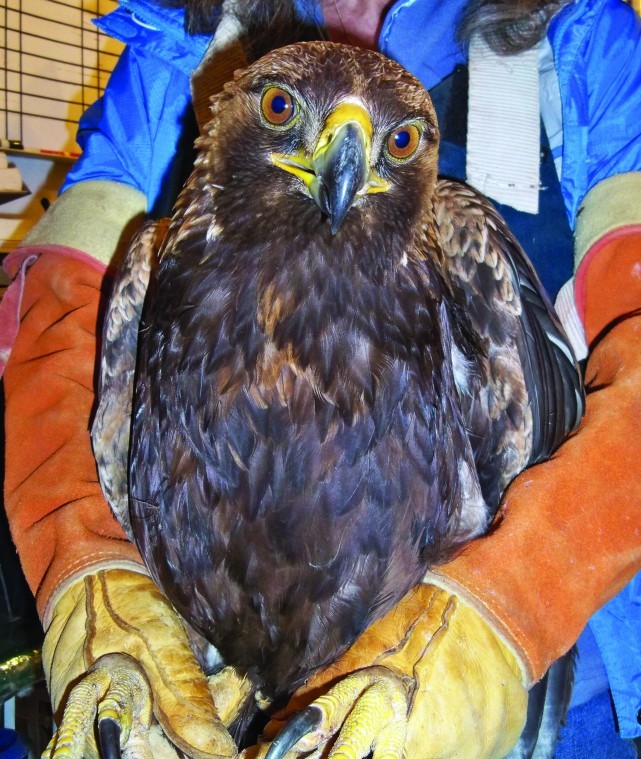On Feb. 28, the Wildlife Education and Rehabilitation Center received a call from Almaden Quicksilver County Park in San Jose about an adult golden eagle found struggling on the ground and powerless to fly away.
John and Teresa Stephenson, two of WERC’s long-time volunteers, drove from Morgan Hill to the park and met ranger Gina Ellis, who told them that the eagle had since moved to the top of the hill – about 30 feet above the road. The three hiked up the hill and attempted to capture the raptor, but naturally, the eagle had a different plan and went off in the opposite direction down on the hill. Carefully clambering over a downed barbed wire fence, Teresa was able to approach within 10 feet of the eagle before he took off running again.
Fortunately, this time the eagle darted into some thick bushes and Teresa was able to get close enough to cover it with a towel. The powerful raptor promptly became still and calm. With extreme caution – its massive talons can be lethal and an eagle can kill a small deer – the eagle was picked up and carried down the hill, then passed under the fence to John. Everyone breathed a deep sigh of relief.
Now it was time to find out why this magnificent bird-of-prey was on the ground. The eagle was taken to Dr. Suzanne Colbert for an examination and X-rays of his wings (he has a 6-foot wingspan). Everyone was elated to hear that there were no fractures as had been feared. Though there was a small wound on the left wrist, possibly caused by an entanglement with barbed wire, it was felt that there was possible head trauma, i.e. a concussion, and that could be the cause of its incapacity.
Dr. Colbert bandaged the eagle’s wing, administered fluids and medication, and sent him back to WERC for TLC. The eagle, underweight at 7 pounds (a healthy male should weigh about 10 pounds), will remain in intensive care for several more weeks, but WERC is cautiously optimistic about his prognosis.
WERC is certainly up to the challenge of caring for this eagle. WERC volunteers were specially trained in eagle rehabilitation in a week-long session in Alaska some years ago, at their own expense. They received rigorous training in handling, medication, behavior and more. Their knowledge was passed on to other volunteers, continuing to this day.
WERC has rehabilitated many eagles over the past 18 years, including a bald eagle that broke its wing when it collided with a truck on Pacheco Pass and Orion, the golden eagle that had a plate surgically inserted in his broken leg and who later became an educational raptor at the Center for Birds of Prey in South Carolina. Once eagles are well on the road to recovery, they are transferred to WERC’s 100-foot flight aviary (the only one in Santa Clara County) to build up stamina and muscles for their eventual release.
On March 7, the eagle was re-examined by Dr. Colbert, who said the wound was healing very well, though the wing will require daily physical therapy and the eagle is to continue antibiotics and pain medication. There was one set-back – a comprehensive analysis of the eagle’s X-rays showed a possible fracture of the coracoid (part of the shoulderblade). This small bone is extremely important to flight and the prognosis has become more guarded for the eagle’s eventual release.
After the news report was aired, a San Jose resident phoned WERC and said she has seen a female golden eagle nesting in the area where this injured male had been found. The caller said the male has not been seen recently and it is believed he may be the one currently recuperating at WERC.
Everyone involved in the eagle’s care is keeping their fingers crossed that soon this beautiful golden eagle will once again spread his wings and soar gracefully in the skies over the open country and hills of San Jose and beyond.










